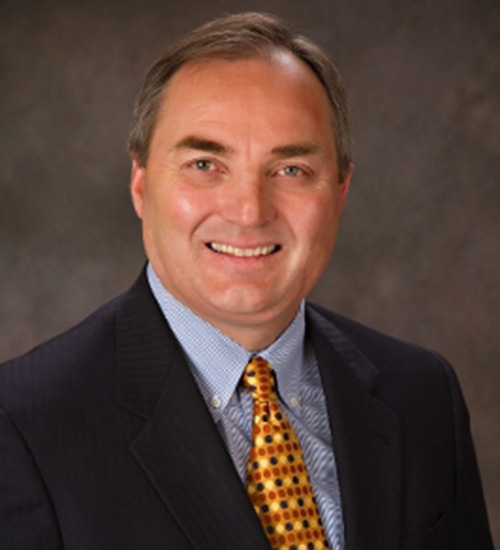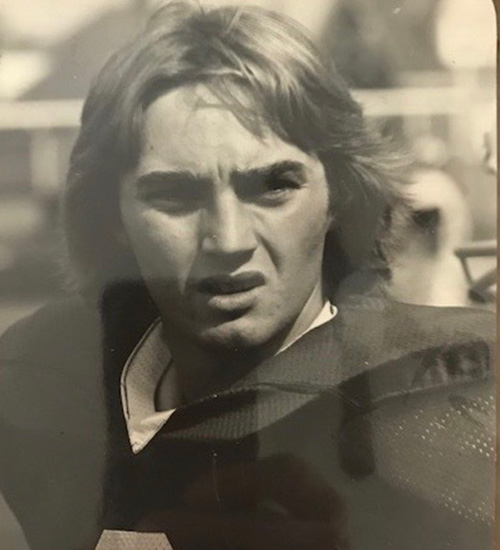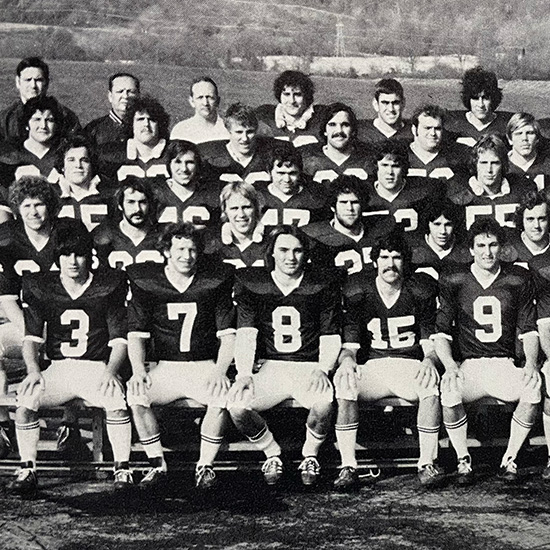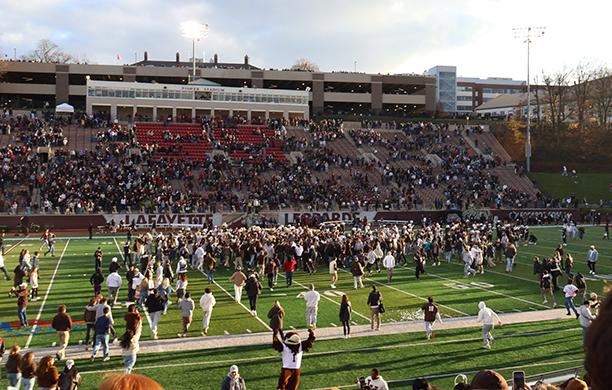Lyle Hogg ’76 peeled off his melting headset. It was fusing to his skin as flames engulfed the cockpit. Smoke, billowing into the cabin of the small commuter jet, choked passengers. The plane was going down. Hogg and the captain had to land before the fire reached the fuel reserves.

With communication lost and little hope of making it to the closest airport in Providence, Rhode Island, the pilots eyed the icy forest below them. In the distance, they spotted an open space for an emergency landing.
The frozen surface of the Scituate Reservoir could be their saving grace. The captain pointed the nose down and prepared for impact. The solid ice sheared off the landing gear, wing, and tail, slowing the burning plane into a snowy skid across the lake. The ice held. The plane burned down to its iron frame.
Passengers and pilots crawled from the wreckage. State police, firefighters, and local neighbors were on hand to transport survivors to the closest hospital through 17 miles of back country roads.
Hogg was burned over 30% of his body. The captain over 70%. Both suffered from smoke inhalation and crash-related injuries. Nine of the 10 passengers on Pilgrim Airlines Flight 458 survived that fateful February day.
One week earlier, Hogg had married his sweetheart on Valentine’s Day. His recuperation was no honeymoon. He spent months in the hospital.
While his heroism earned him commendations and a trip to the White House, the crash didn’t ground his love of flying. Not only did he return to the cockpit, but over his career, he also led the investigation of a famous crash landing on the Hudson River and served as president and CEO of Piedmont Airlines.
But his heroics really started at Lehigh.
The Catch Against Penn
Hogg remembers a weekend drive to investigate Pennsylvania colleges. He stopped at Lafayette first, but it was a lifeless ghost town. He only realized later while touring at South Mountain that those students were at Lehigh for the Rivalry game. The campus was teeming with people, the blaring sounds of the Marching 97, and raucous cheers rising from Taylor Stadium. He found his home.

He planned to play baseball, but after attending a football game, he decided to go to a walk-on tryout in hopes of joining the men on the gridiron. He made the freshman team and was called up to varsity as a sophomore, meeting coach Fred Dunlap.
Growing up, he viewed his coaches as mentors. Dunlap fit that description. Hogg remembers being down at halftime in a game. Rather than giving a blustering speech to players in the locker room, Dunlap remained calm, deliberate, and strategic. In the second half, the coach made critical adjustments and the team dominated the field, crawling back to win by a field goal.
Dunlap even dressed a young Hogg to play in a game near his hometown in Connecticut, just so his family could come cheer him on.
But Hogg’s big moment came as a senior when Lehigh battled Penn. Lehigh’s top cornerback went out with a concussion, so Hogg was put in to cover Penn’s star receiver.
Of course, the Quakers sought to take advantage of the apparent mismatch. On the very next play, the receiver darted a deep route to the goal line, but the pass was underthrown. Hogg intercepted and ran 98 yards before being knocked out of bounds at Penn’s two-yard line.
Hogg remembers seeing Dunlap screaming and waving as he sprinted downfield. Lehigh punched it in and upset Penn for the first time since 1889 (according to the 1976 yearbook). Hogg was hero for the day.
“Lehigh was a tough place in a tough community,” says Hogg. “Like old Taylor Stadium, with the steel mill as a backdrop and its black clouds chugging out of coke-making smokestacks, teams knew it was going to be tough going when they came to play in Bethlehem. Academically, athletically, and motivationally, I had to learn how to work hard, compete, adapt, and succeed.”

While the finance degree he earned was something he relied on later in life, it wasn’t until he was done sitting at the yoke as a pilot.
Learning to Fly
Hogg got a job after Lehigh at a company back in Connecticut. En route to that job, he’d pass a sign offering a free introductory flying lesson. He couldn’t let the thought go, so one day he stopped. Soon, he was in the air and got hooked. That’s when he began pilot lessons.
Flight school in Florida came next. Then a stint in San Diego as a flight instructor while his fiancée was a nurse for the Navy.
When a Lehigh friend mentioned how commuter and regional airlines were looking for pilots, Hogg came back east and joined Pilgrim Airlines in 1981.
Following the crash in 1982, Hogg was still enamored with flying and had no interest in an office job. He returned to the cockpit as a copilot and then moved up to captain. For 20 years, he flew out of Washington, D.C., for US Airways as a first officer. In 1996, he was named chief pilot.
While he flew throughout his career, he moved into other flight operations management roles at US Airways and American Airlines in Pittsburgh, then Phoenix, and finally Dallas.
A Landing on the Hudson
As vice president for flight operations, one day, he held a chief pilot meeting to review roles during an emergency. At the conclusion of that meeting, he warned there might be a drill soon.
Little did he know that later that day, Chesley “Sully” Sullenberger would make an emergency landing on the Hudson River. Immediately, Hogg and a go-team were deployed to LaGuardia Airport to be briefed and begin their internal investigation. The team spent a month in New York City, and Hogg was the first person to interview Sully following the crash.

Of course, many teams were on the ground as the plane manufacturer, Federal Aviation Administration, and National Transportation Safety Board gathered facts, posited theories, and made assessments.
According to the analysis by Hogg’s team, the pilots on Flight 1549 did everything right, following protocols for rest, procedures, checklists, and decision-making when both engines failed due to bird strikes.
“I would always tell our pilots that you never know upon which flight their career will be judged, so make each one their very best,” says Hogg. “But our simulations never had Sully’s plane making it back to a runway. He averted a fatal disaster and saved many lives despite the heavy scrutiny he faced.”
Following several airline mergers, Hogg was asked to take the helm at Piedmont Airlines to help transition its fleet from prop planes to a regional jet carrier. He led that charge, serving the company from 2015 until his retirement in 2021.
“As a leader, I relied heavily on my degree from Lehigh as I ran the company and managed people,” he says. “I was thankful that I had that academic experience.”
He got a call one day on the golf course from the CEO of American Airlines, who asked how Hogg was hitting them. He was honest: His handicap wasn’t where he wanted it. Hogg was easily lured back into work, managing the pilot training department at American to help return the airline to pre-COVID-19 levels.
While he enjoyed preparing future captains, Hogg has retired again … This time for good. He now spends time with his children and grandchildren and stays connected to the cockpit through his son, a pilot at American.
He also stays connected at Lehigh, returning for his 50th Reunion, where he celebrated with his fraternity brothers and Lambert Cup team. Hogg has also come back to tailgate before a big football game. That’s where he saw Coach Dunlap run up the steps as a limber 90+-year-old.
“That sight reminded me of the great men Lehigh creates. They motivate others and make an impact,” he says.
Spoken like a humble hero.


